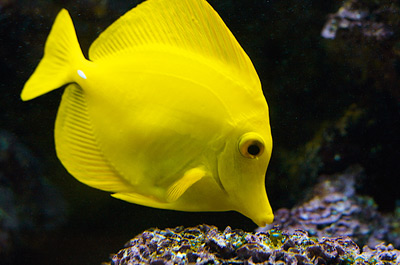The practice of adding herbivorous fish and/or invertebrate species to marine aquariums for the purpose of nuisance algae control is quite commonplace. Hence the popularity of those herbivore packages known in hobby parlance as “cleanup crews,” or CUCs. But almost as common is the experience of adding a herbivorous species or CUC to eradicate algae only to discover that it doesn’t quite live up to expectation. Why does this sometimes happen? Here are a few possibilities:
The alga isn’t on the menu
We like to think that herbivores will feast on any and all algae put in front of them, but most are more discerning than that. For example, many herbivorous fish and inverts may do a great job of grazing diatoms and algal films but then completely ignore the forms of most concern to hobbyists, such as those tough, unsightly strands or clumps of hair-type algae.
In fact, my experience with marine herbivores in general is that few will actually outright consume growths of hair algae. The Turbo and Astraea spp. snails commonly included in CUCs come to mind here. Many sources claim they’ll devour hair algae, but none of the specimens I’ve kept have ever done so despite making quick work of diatoms and algal films. Maybe I’ve just had bad luck.
There’s too much algae
In some cases, a herbivore is actually eating the algae in your tank but falls short of expectations simply because it can’t keep pace with the rate of algae production—sort of like Lucy and Ethel in the chocolate factory. In this situation, the nutrient input side of the equation is clearly way out of balance with the nutrient export side, so you have to address that through improved water changes and protein skimming, reduced feeding, etc. before you can expect to get the algae problem under control.
The specimen is too well fed
If a herbivorous fish fills up on all kinds of prepared foods offered by you, it may show little interest in grazing the algae in your tank whether it happens to be on its natural menu or not. This can present something of a dilemma because on the one hand, you don’t want to risk starving the fish by withholding food, but on the other hand, you would like to encourage its natural grazing behavior.
The best you can do in this scenario is try to cut back incrementally on the amount or frequency of feeding until you strike the right balance. Of course, this may not be feasible depending on the other livestock in your tank. For instance, if you have planktivorous fish in the same tank that demand multiple meals per day, withholding feedings would be counterproductive.
Individual results vary
Sometimes individual specimens of a given species of fish or invertebrate just behave outside the norm, and this can apply to algae-eating tendencies as well. As I mentioned in a prior post, some hobbyists have great success using Mithraculus sculptus crabs for bubble algae control, while others (myself included) have no such luck. Similarly, one yellow tang (Zebrasoma flavescens) might go right to town on hair algae growing in its tank while another might turn up its long snout at the stuff. Who’s to say why?



